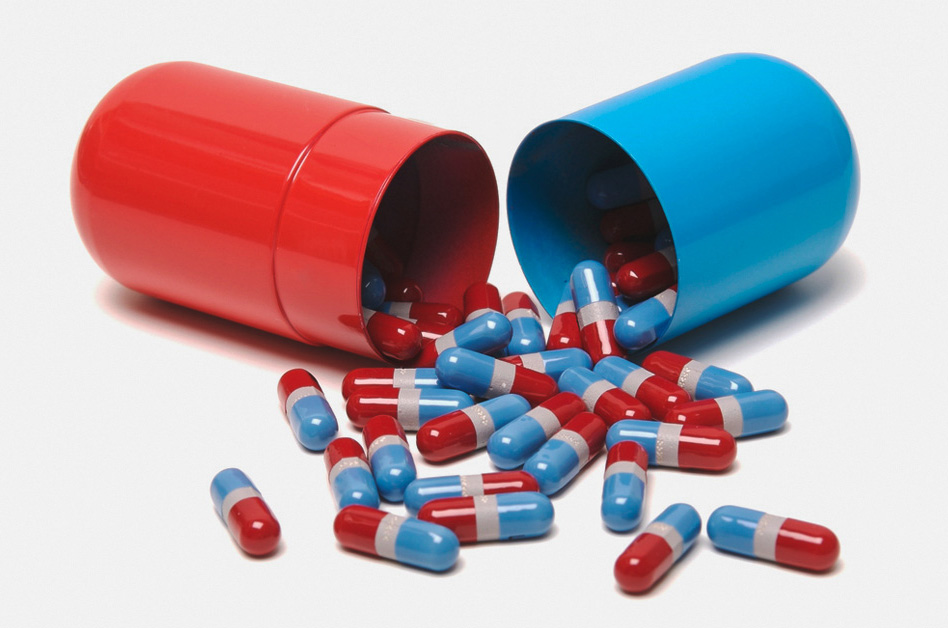Note: We have defined terms marked in (*) in the glossary at the end of this article
Antibiotics(*) are medicines that can kill or suppress harmful bacteria. St. Lawrence Dentistry takes the stewardship of antibiotic use very seriously, as overuse of these crucial medications can lead to resistance over time.
Antibiotics can be “bactericidal” (destroy bacteria) or “bacteriostatic” (inhibit bacterial growth).
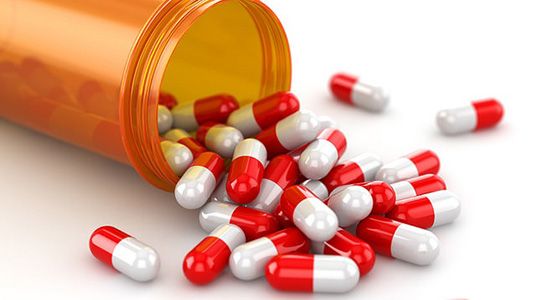
There are different mechanisms by which antibiotics work; some inhibit the synthesis of cell walls (*), proteins, and nucleic acid (genetic material).
Beta Lactams (*) constitute a significant class of antibiotics. They include penicillin, cephalosporins, monobactams, and vancomycin. These antibiotics are bactericidal and have a “beta lactam” ring. It inhibits bacterial enzymes called transpepidase (*), which is needed to form a “cell wall” (*). Penicillins have the advantage of having low toxicity because humans do not have cell walls (hence the antibiotics target the bacteria only). However, one negative aspect of this class of antibiotics is allergic reactions to penicillin occur in about 10-12% of people.
Penicillin G (intravenous form) and Penicillin V (oral form) are suitable against oral anaerobes (*). However, they will only work against bacteria that do not produce beta-lactamase. If a bacterium is resistant to Penicillin, other antibiotics are available which may be effective. While talking about the use of Penicillin “V” versus “G”, it is worth noting that intravenous antibiotics will get more concentration of antibiotics into blood vessels quicker. Penicillin V is generally not given more than 500mg at a time because that is all a typical patient can absorb through the oral route. If one of our patients needs an antibiotic like Penicillin G, we will refer to the nearby Mississauga Trillium Hospital for its intravenous administration.
Sometimes there is a need for Beta Lactams other than penicillin. For example, Ampicillin and Amoxicillin can have the following advantages:
- Better absorption.
- Effectiveness against gram-positive Enterococcus, listeria, and gram-negative bacilli bacteria.
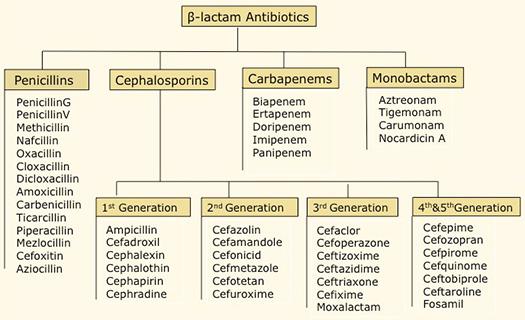
Some bacteria can produce enzymes, called “beta lactamases”, that can destroy penicillin. Their production is mainly by a group of bacteria called gram negative (*). Modern medicine has developed “beta lactamase” resistant bacteria drugs to attack these beta-lactamases.
Examples of these are:
- Clavulanic acid (also known as Augmentin).
- Tazobactam.
- Sulbactam.
Often clavulanic acid is used with amoxicillin to combat bacteria posing resistance to penicillin. We use this combination in dentistry if there is no resolution of infection in 2-3 days by solely using a “beta lactam” antibiotic.
One standard prescription written is the following:
- Rx Amoxicillin 500mg + Clavulanate 125mg (3 times a day for 7 days)
Antibiotics that work by inhibiting protein synthesis include macrolides, clindamycin, tetracyclines, and aminoglycosides. These are all bacteriostatic. With this group of antibiotics, it is generally necessary not to use dairy products or iron supplements as they render these less effective.
When a patient has a long-term infection in their gums, sometimes an antibiotic called Periostat is used. Another name for it is “doxycycline”.
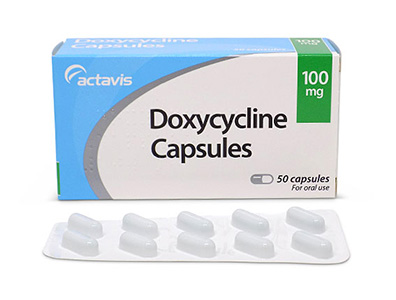
A typical prescription for this looks like this:
- Rx Doxycycline 100mg for 21days (Periostat)
Clindamycin is a very common antibiotic used in dentistry and works by inhibiting protein synthesis. It is the drug of choice if one has a penicillin allergy. It binds into the “50S subunit” of the “ribosomes” (*) in bacteria, thus inhibiting the “translocation step” of protein synthesis (*). Clindamycin is bacteriostatic and is effective against gram-positive, anaerobic bacteria. Side effects are diarrhea, skin rashes, and liver toxicity.
In addition, one primary side effect of clindamycin is pseudomembranous colitis. Its characteristics include severe diarrhea and abdominal pain.

We prominently used Tetracyclines in dentistry in the past, but their use has waned due to bacterial resistance. In addition, they have a high affinity for calcium and can discolor enamel or teeth in adults, children, and fetuses. They may retard skeletal function if taken during pregnancy. Other side effects of tetracycline are gastric discomfort, fungus superinfection, and blood in the stool.
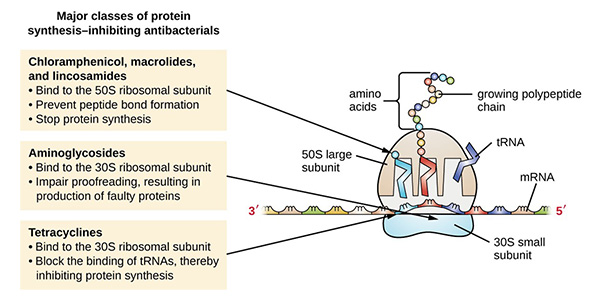
Macrolides are a group of common antibiotics, of which “erythromycin” is the most prominent example. These were among the first drugs available that were effective for patients with an allergy to beta-lactam antibiotics. Macrolides are inhibitors of the cytochrome p450 enzyme (*) in the liver. Therefore, they may increase the concentration of common drugs such as warfarin, phenytoin, carbamazepine, and cyclosporine. It means that macrolide could potentially cause an overdose of the above medications if the doctor does not appropriately prescribe it.
Another set of antibiotics is those that function by inhibiting genetic information synthesis. Two examples of these are metronidazole and ciprofloxacin. Metronidazole is bactericidal and is effective against a bacteria called “Bacteroides”. It works well in certain instances in combination with amoxicillin. However, Metronidazole also may inhibit an enzyme called “aldehyde dehydrogenase”. The enzyme can helps break down alcohol in your body. Therefore, Drinking alcohol with this antibiotic can cause, among other issues, redness, and joint pain. For this reason, it is best not to take alcohol until at least 2-3 days after finishing this drug. Other side effects are an unpleasant metallic taste, gastrointestinal issues, and dizziness.
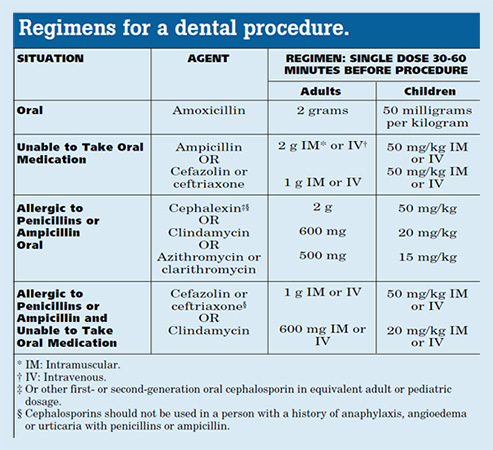
In dentistry, we give antibiotics to certain patients before some procedures to attenuate bacteria entering their bloodstream. It is called “antibiotic prophylaxis” and is indicated (among other instances) for:
- Patients with prosthetic heart valves.
- A history of endocarditis, cardiac transplant patients with subsequent heart valve issues.
- Congenital heart defects, and patients who have had repair of heart defects.
It is not usually indicated for surgically constructed systemic pulmonary shunts, previous coronary artery bypass surgery, physiological (functional, innocent) heart murmurs, pacemakers, and implanted defibrillators. However, St. Lawrence Dentistry may consult with your physician to see if you should have antibiotic prophylaxis when having your dental work done. In general, we prescribe prophylactic antibiotics to those individuals for procedures that could cause significant bleeding.
Currently, the Canadian Dental Association is not recommending prophylactic antibiotics for most patients with orthopedic pins and screws. However, some surgeons may recommend prophylaxis in the first two years post-surgery if a patient is immunocompromised or has had previous joint infections. In general, the Canadian Dental Association (as of 2019) recommends choosing the narrowest spectrum antibiotic drug which can be effective.
Some typical adult dosages for antibiotics prophylaxis are:
- Amoxicillin 2grams
- Clindamycin 600mg
- Azithromycin 500mg
- Clarithromycin 500mg
Not all dental abscesses are the same, and we must carefully assess each situation. The choice or combination of an antibiotic may change depending on how long the dental abscess has been present. If an abscess festers for 7-10 days, it has probably become more non-aerobic. In this case, adding an antibiotic that combats aerobic bacteria may be indicated. One example of this is the above-discussed Metronidazole. Sometimes if an abscess leaks into the mouth, an antibiotic rinse such as those based on clindamycin and tetracycline can help. Dr. Hawryluk will assess your situation to see what is best for you.
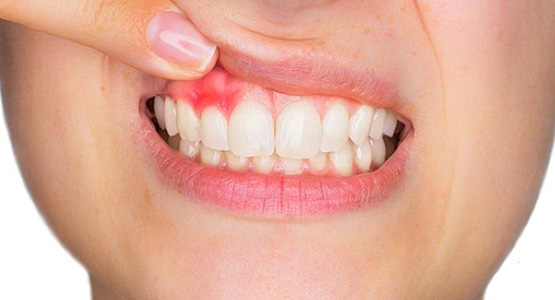
Dental abscesses (*) are not well vascularized, and the vessels it has are mainly peripherally. Therefore, antibiotics must diffuse from vessels to the abscessed tissue along a concentration gradient. The larger the abscess, the less effective an antibiotic will be in clearing it up. Sometimes, the abscessed area is “drained” to make antibiotics more effective. It makes the vascular perimeter of the abscess smaller. Hence, more concentration of an antibiotic will be able to reach the interior of the abscess.
Antibiotics have been a significant development that has helped advance dentistry and humankind. We take antibiotics very seriously at St. Lawrence Dentistry and will ensure appropriate use. If you live in the Mississauga area and would like to discuss this subject or would like a dental appointment, please call us.
Glossary of Terms:
- Antibiotic – a medicine (such as penicillin or its derivatives) that inhibits the growth of or destroys microorganisms.
- β – lactam antibiotics: are antibiotics that contain a beta-lactam ring in their chemical structure. It includes penicillin derivatives and cephalosporins.
- Transpeptidase – An enzyme that catalyzes a reaction necessary for building bacterial cell walls.
- Cell wall – a structural layer surrounding some types of cells, just outside the cell membrane.
- Anaerobic bacteria – bacteria that do not live or grow when oxygen is present.
- Beta-lactamase – bacterial enzymes that inactivate the penicillins and cephalosporins by hydrolyzing them.
- Gram – negative bacteria do not retain the crystal violet stain used in the Gram-staining method of bacterial differentiation.
- Ribosome – an intercellular structure made of both RNA and protein, and it is the site of protein synthesis in the cell.
- Proteins – large, complex molecules that play many critical roles in the body.
- Protein synthesis – The process of arranging amino acids into proteins through the involvement of ribosomal RNA, transfer RNA, messenger RNA, and various enzymes.
- Cytochrome p450 – A group of enzymes involved in drug metabolism and found in high levels in the liver. These enzymes change many drugs, including anticancer drugs, into less toxic forms that are easier for the body to excrete.
- Enzyme – a substance produced by a living organism that acts as a catalyst to biochemical reactions.
- Dental abscess – a build-up of pus in the teeth or gums caused by an infection.
- RNA – a nucleic acid present in all living cells. Its principal role is to act as a messenger carrying instructions from DNA to control protein synthesis.
- Nucleic acids – are naturally occurring chemical compounds that serve as the primary information-carrying molecules in cells.
Reference:
University of Toronto, Faculty of Dentistry, Online Lecture Series, 2019.
https://www.genome.gov/genetics-glossary/Ribosome
https://medlineplus.gov/genetics/understanding/howgeneswork/protein/
https://www.cancer.gov/publications/dictionaries/cancer-terms/def/cytochrome-p450-enzyme-system
- St. Lawrence Dentistry Looks Forward To St. Patrick’s Day! - March 12, 2025
- Understanding Dental X-Rays and Radiation: What You Should Know - January 13, 2025
- Happy New Year from St. Lawrence Dentistry! - December 30, 2024



